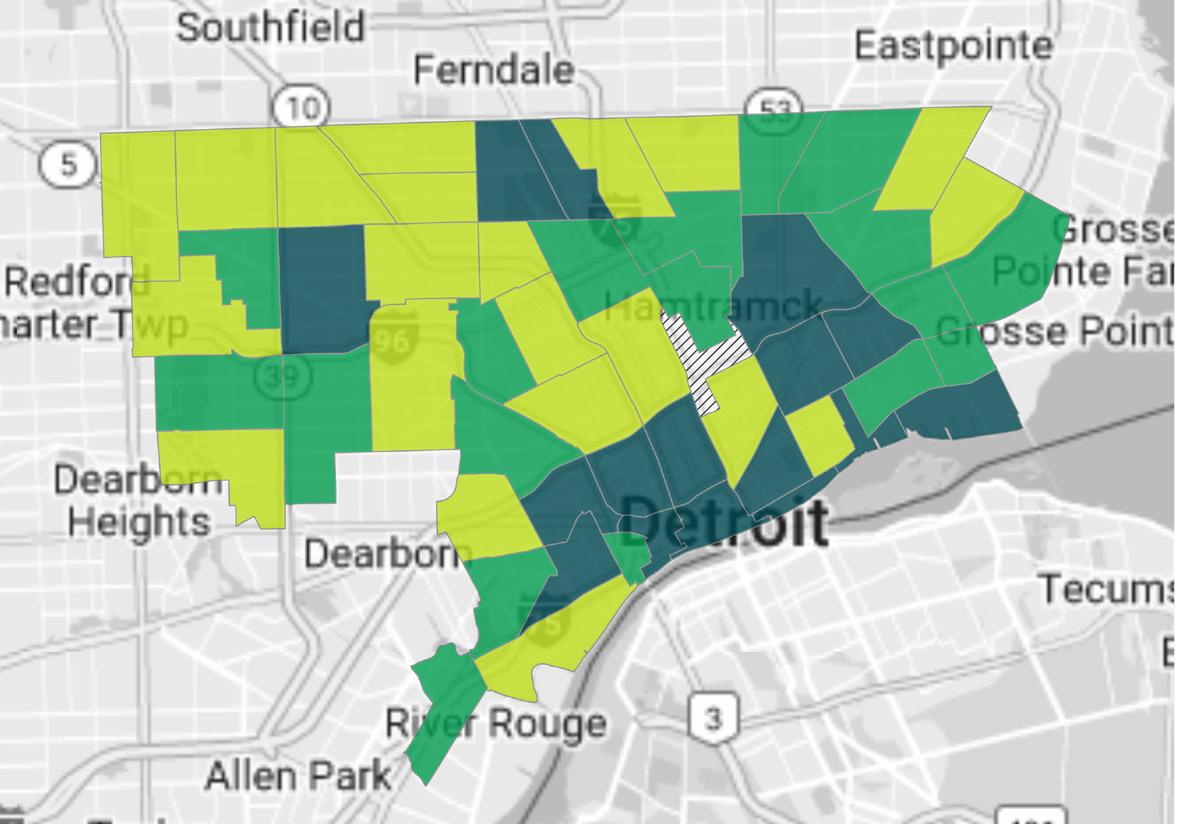
5 minute read
2 Education and Employment Opportunities
Education and employment opportunities, as discussed above, are strongly associated with how Detroiters feel about the quality of their lives. In light of this association, it is necessary to understand how Detroiters feel about the availability and quality of important educational and financial opportunities in their city.
Poverty remains widespread in Detroit and is far more common among Black and Hispanic city residents than White city residents.
Overall, 43% of city residents say there were times in the past year when they didn’t have enough money to buy food for themselves or their families, while 23% say they didn’t have enough to provide adequate shelter or housing. The latter figure coincides with a 2022 report by the University of Michigan estimating that about one in five Detroit renters faced eviction that year.7
7 https://www.detroitnews.com/story/news/local/detroit-city/2022/12/14/detroit-mayor-duggan-taps-leaders-for-office-ofeviction-defense/69727955007/
In each case, Black and Hispanic city residents are more likely than White city residents to have struggled (Chart 2). Black and Hispanic city residents also fared poorly compared to results from the total U.S. population for food (27%) and shelter (17%). However, White city residents’ rates are similar or better than the national average.
CHART 2
Percent who say there were times in the past year when they did not have enough money for each
To buy food that you or your family needed
To provide adequate shelter or housing for you and your family
Though suburban residents are less likely overall than city residents to have had trouble paying for food and shelter in the past year, the racial gaps in these metrics are no less pronounced than those among residents in the city. For example, more than three in 10 Black (38%) and Hispanic (31%) suburbanites say there were times when they did not have enough money for food — more than twice the 14% among White suburban residents.
In fact, Black suburban residents are only somewhat less likely than Black city residents to have had trouble paying for food or shelter, indicating that racial equity gaps in basic living standards extend beyond the city’s borders.
Reports of struggling to afford food are among the greatest in four neighborhoods in the city, where more than half of residents struggled to buy food in the past year: Rouge (57%), Winterhalter (57%), Rosa Parks (53%) and Mackenzie (51%).
Reports of difficulty affording shelter are among the greatest in the Nolan neighborhood, where a majority of residents (52%) say they have struggled in the past year. More than a third of residents struggled in the neighborhoods of Redford (37%) and Conner (35%).
With economic concerns central to so many Detroiters’ lives, it makes sense that factors relating to residents’ economic empowerment — including access to high-quality education and employment opportunities — are among the dimensions most strongly related to overall life evaluations for both city and suburban residents.
Nearly 4 in 10 Detroit city residents satisfied with availability of good jobs
About four in 10 city residents in Detroit (39%) say they are satisfied with the availability of good jobs in their area, with only minor differences between Black (38%), Hispanic (42%) and White (43%) residents. Though there is some variation by education level, even among city residents with a bachelor’s degree or higher, less than half (44%) are satisfied with the availability of jobs in the city. CHART
Satisfaction with the availability of good jobs is among the lowest in the neighborhoods of Nolan (23%) and Mackenzie (24%), where fewer than one in four residents are satisfied. Meanwhile, majorities of residents are satisfied with the availability of good jobs in East Riverside (60%), Indian Village (58%) and the Central Business District (52%).
Note: Upper East Central neighborhood had no responses. Neighborhood count: Low=19, Mid=18 and High=17.
Among suburban residents, satisfaction with job availability rises sharply to 72% — even higher than the corresponding 66% among Americans overall. There is a clearer distinction between Black suburban residents, 57% of whom are satisfied with job availability, and Hispanic and White residents, of whom 76% each are satisfied (Chart 3). These racial gaps are present even after controlling for suburbanites’ education level; for example, 61% of Black residents with a bachelor’s degree or higher are satisfied with local job availability, versus 69% of Hispanic residents and 84% of White residents with at least a four-year degree.
Overall, 12% of city residents say they are unemployed but looking for work; among those in the suburbs, 4% respond this way — much closer to the national unemployment rate when the survey was conducted. That difference is largely related to the gap in educational attainment between city dwellers and suburbanites. Among city residents with a bachelor’s degree or higher, 4% say they are unemployed and looking for work, compared to 13% of all other city residents. Within the city of Detroit, residents with higher education degrees have unemployment rates that are similar to the rate among suburban residents.

The lack of jobs for less-educated residents suggests targeted upskilling efforts are particularly important in allowing more Detroiters to earn a living wage. Among those currently unemployed and looking for a job, 44% of city residents and 42% of suburban residents say their level of training has posed a barrier (Chart 4).
Many job-seekers in the city of Detroit also face transportation-related barriers; 51% say access to a car has kept them from finding or keeping a job, while 44% say the same about convenient public transportation. Detroit has the most expensive average auto insurance rate of any major U.S. city,8 making car ownership cost-prohibitive for some low-income residents. Moreover, the city’s public transit system doesn’t extend to many areas — including suburban communities — where jobs are more readily available.9
Chart 4
In the past 12 months, have you personally experienced any of the following barriers to finding or keeping a job?
In addition to the relatively high proportion of jobless city residents, many employed city residents are dissatisfied with their current position; 45% say they are interested in finding a new job. Workers in the city of Detroit who respond this way most commonly wish for a higher salary or wages (86%), followed by better benefits (63%) and more opportunities for promotion (62%). Notably, Black employees are more likely than others in the city to cite a work environment with less harassment and discrimination as a reason to find a new job — 43% versus 26%, respectively (Chart 5)
8 https://www.marketwatch.com/guides/insurance-services/10-most-expensive-cities-to-own-a-car-in-2023/
9 https://www.freep.com/story/opinion/columnists/stephen-henderson/2015/02/22/detroit-bus-transit/23775245/
Why
City residents’ desire for higher-paying jobs with advancement opportunities speaks to the importance of efforts that help residents gain the skills to attain middle-class incomes. Here also is a need for greater access to targeted training opportunities in high-growth industries. Currently, 22% of Detroiters rate it easy to access job training services in the city, while 36% say it is difficult (18% say they don’t know or the question does not apply to them).
The lack of affordable housing in the city likely undermines many residents’ sense of financial security. Low average incomes and increasing construction costs have constricted the housing supply, keeping rent and property values high.10
Overall, 29% of city residents say they are satisfied with the availability of good affordable housing in their area, compared with 50% of Americans overall (Chart 6).
A 2022 University of Michigan study found that about 39,000 Detroit households were spending more than half their income on rent or mortgages — well above the 30% commonly considered affordable.11
CHART 6
In the city or area where you live, are you satisfied or dissatisfied with the availability of good affordable housing?
Satisfaction with the availability of good, affordable housing is among the lowest in five neighborhoods, where fewer than one in five residents are satisfied: Pershing (15%), Nolan (16%), Denby (17%), Jeffries (19%) and Rosa Parks (19%). In just two neighborhoods — Winterhalter (41%) and Indian Village (40%) — are two in five or more of the residents satisfied with housing availability.
10 https://www.crainsdetroit.com/crains-forum/detroit-among-worst-cities-affordable-housing-cost-relief
11 https://detroitsurvey.umich.edu/wp-content/uploads/2022/05/DMACS-Economic-well-being-two-years-into-pandemicMay2022.pdf
Just under half of city residents (48%) say they own their primary residence, with a substantial racial gap; while 45% of Black city residents say they own their homes, that figure rises to a majority among White (59%) and Hispanic (61%) city residents (Chart 7).
While Black suburbanites are only about as likely as Black city residents to say they own their homes, Hispanic and White suburbanites are significantly more likely than their counterparts in the city to be homeowners











